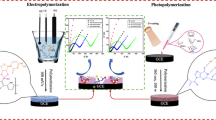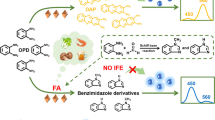Abstract
A facile method which combines the advantages of carbon quantum dots and molecular imprinting technology to design a fluorescence molecular imprinting sensor for the high sensitivity and selective detection of chloramphenicol. The fluorescent molecule imprinted polymers are synthesized by sol-gel polymerization using carbon quantum dots as functional monomers and fluorescent sources, TEOS as crosslinkers, breaking with the traditional understanding of an additional functional monomer. Under optimal experimental, as the concentration of chloramphenicol increases, the fluorescence intensity of the fluorescence molecule imprinting sensor gradually decreases. The concentration of chloramphenicol is linear in the range of 5–100 µg/L and the detection limit is 1 µg/L (N/S = 3). The sensor is able to detect chloramphenicol in milk, enabling the application of real samples. The results show that this work provides an easy method to preparing fluorescent molecular imprinting sensors for the detection of chloramphenicol in milk.






Similar content being viewed by others
Data Availability
It is not possible to share research data publicly. If you need the raw data, you can contact me by email. The experiment didn’t involve ethics approval and consent to participate.
References
Bayrakci M, Keskinates M, Yilmaz B (2021) Antibacterial, thermal decomposition and in vitro time release studies of chloramphenicol from novel PLA and PVA nanofiber mats. Mater Sci Eng C 122:111895. https://doi.org/10.1016/j.msec.2021.111895
Xu J, Yin W, Zhang Y, Yi J, Meng M, Wang Y, Xue H, Zhang T, Xi R (2012) Establishment of magnetic beads-based enzyme immunoassay for detection of chloramphenicol in milk. Food Chem 134:2526–2531. https://doi.org/10.1016/j.foodchem.2012.04.083
Zhang T, Yang Y, Li X, Jiang Y, Fan X, Du P, Li H, Wang N, Zhou Z (2021) Adsorption characteristics of chloramphenicol onto powdered activated carbon and its desorption performance by ultrasound. Environ Technol 42(4):571–583. https://doi.org/10.1080/09593330.2019.1637464
Luo L, Gu C, Li M, Zheng X, Zheng F (2018) Determination of residual 4-nitrobenzaldehyde in chloramphenicol and its pharmaceutical formulation by HPLC with UV/Vis detection after derivatization with 3-nitrophenylhydrazine. J Pharmaceut Biomed Anal 156:307–312. https://doi.org/10.1016/j.jpba.2018.04.024
Chen D, Delmas J-M, Hurtaud-Pessel D, Verdon E (2020) Development of a multi-class method to determine nitroimidazoles, nitrofurans, pharmacologically active dyes and chloramphenicol in aquaculture products by liquid chromatography-tandem mass spectrometry. Food Chem 311:125924. https://doi.org/10.1016/j.foodchem.2019.125924
Hue NT, Pham TN, Dinh NX, Van Tuan H, Thuy NTT, Nam MH, Lam VD, Le A-T, Huy TQ (2022) AuNPs-modified screen-printed electrodes (SPCE and SPPtE) for enhanced direct detection of chloramphenicol. J Electron Mater 51(4):1669–1680. https://doi.org/10.1007/s11664-022-09434-9
Xie Y, Zhao M, Hu Q, Cheng Y, Guo Y, Qian H, Yao W (2017) Selective detection of chloramphenicol in milk based on a molecularly imprinted polymer–surface-enhanced Raman spectroscopic nanosensor. J Raman Spectrosc 48(2):204–210. https://doi.org/10.1002/jrs.5034
Banerjee R, Ghosh D, Bhaduri SN, Biswas R, Biswas P (2023) Electrochemical Detection of Chloramphenicol using Metal Free ordered Mesoporous Carbon. Chem Select 8(1):e202202433. https://doi.org/10.1002/slct.202202433
Gao Z, Du X, Ding Y, Li H (2021) Establishment of a dual-aptasensor for simultaneous detection of chloramphenicol and kanamycin. Food Addit Contam A 38(7):1148–1156. https://doi.org/10.1080/19440049.2021.1914871
Ding H, Li C, Zhang H, Lin N, Ren W-S, Li S, Liu W, Xiong Z, Xia B, Wang C-C (2023) A simple fluorescent sensor for highly sensitive detection of UO22+. Chin Chem Lett 34(4):107725. https://doi.org/10.1016/j.cclet.2022.08.005
BelBruno JJ (2018) Molecularly imprinted polymers. Chem Rev 119(1):94–119. https://doi.org/10.1021/acs.chemrev.8b00171
Xia C, Zhu S, Feng T, Yang M, Yang B (2019) Evolution and synthesis of carbon dots: from carbon dots to carbonized polymer dots. Adv Sci 6(23):1901316. https://doi.org/10.1002/advs.201901316
Zhong Y, Chen A, Yin X, Li R, Deng Q, Yang R (2023) Red Emission Carbon Dots for Mitoxantrone Detection. Sen Actuators B Chem 382:133535. https://doi.org/10.1016/j.snb.2023.133535
Liang G, Zhai H, Huang L, Tan X, Zhou Q, Yu X, Lin H (2018) Synthesis of carbon quantum dots-doped dummy molecularly imprinted polymer monolithic column for selective enrichment and analysis of aflatoxin B1 in peanut. J Pharmaceut Biomed Anal 149:258–264. https://doi.org/10.1016/j.jpba.2017.11.012
Dehghani Z, Akhond M, Absalan G (2021) Carbon quantum dots embedded silica molecular imprinted polymer as a novel and sensitive fluorescent nanoprobe for reproducible enantioselective quantification of naproxen enantiomers. Microchem J 160:105723. https://doi.org/10.1016/j.microc.2020.105723
Li K, Zhang M, Ye X, Zhang Y, Li G, Fu R, Chen X (2021) Highly sensitive and selective detection of naproxen via molecularly imprinted carbon dots as a fluorescent sensor. RSC Adv 11(46):29073–29079. https://doi.org/10.1039/D1RA04817A
Zhang X, Tang B, Li Y, Liu C, Jiao P, Wei Y (2021) Molecularly imprinted magnetic fluorescent nanocomposite-based sensor for selective detection of lysozyme. Nanomaterials 11(6):1575. https://doi.org/10.3390/nano11061575
Ensafi AA, Nasr-Esfahani P, Rezaei B (2018) Synthesis of molecularly imprinted polymer on carbon quantum dots as an optical sensor for selective fluorescent determination of promethazine hydrochloride. Sen Actuators B Chem 257:889–896. https://doi.org/10.1016/j.snb.2017.11.050
Xu S, Lu H (2016) Mesoporous structured MIPs@ CDs fluorescence sensor for highly sensitive detection of TNT. Biosens Bioelectron 85:950–956. https://doi.org/10.1016/j.bios.2016.06.020
Ling J, Zhang W, Cheng Z, Ding Y (2022) Recyclable magnetic fluorescence sensor based on Fe3O4 and carbon dots for detection and purification of methcathinone in sewage. ACS Appl Mater Interface 14(3):3752–3761. https://doi.org/10.1021/acsami.1c20170
Xia Y, Zhao F, Zeng B (2020) A molecularly imprinted copolymer based electrochemical sensor for the highly sensitive detection of L-Tryptophan. Talanta 206:120245. https://doi.org/10.1016/j.talanta.2019.120245
Yang Z, Yang K, Cui Y, Shah T, Ahmad M, Zhang Q, Zhang B (2021) Synthesis of surface imprinted polymers based on wrinkled flower-like magnetic graphene microspheres with favorable recognition ability for BSA. J Mater Sci Technol 74:203–215. https://doi.org/10.1016/j.jmst.2020.10.012
Bhogal S, Kaur K, Maheshwari S, Malik AK (2019) Surface molecularly imprinted carbon dots based core-shell material for selective fluorescence sensing of ketoprofen. J Fluoresc 29:145–154. https://doi.org/10.1007/s10895-018-2322-4
Xie C, He J, Meng C, Chen X, Liu H, Sun B (2023) Red emissive N-doped carbon dots encapsulated within molecularly imprinted polymers for optosensing of pyrraline in fatty foods. Microchim Acta 190(3):88. https://doi.org/10.1007/s00604-023-05669-3
Ren Y, Fan Z (2023) Synthesis of fluorescent probe based on molecularly imprinted polymers on nitrogen-doped carbon dots for determination of tobramycin in milk. Food Chem 416:135792. https://doi.org/10.1016/j.foodchem.2023.135792
Funding
This work was fancially supported by the National Natural Science Foundation of China (No. 22274096).
Author information
Authors and Affiliations
Contributions
Hao Liu: Conceptualization, Methodology, Formal analysis, Investigation, Data curation, Writing - original draft, Writing - review & editing. Xuyuan Sun: Resources. Peijie Wu: Resources. Guan Wang: Resources. Jing Yang: Resources. Yan Huang: Resources. Li Li: Supervision, Writing - review & editing. Yaping Ding: Funding acquisition, Supervision, Writing - review & editing. All authors reviewed the manuscript.
Corresponding authors
Ethics declarations
Competing Interests
The authors declare no competing interests.
Ethics Approval
This is an observational study. This declaration is not applicable.
Consent to Participate
Informed consent was obtained from all individual participants included in the study.
Consent to Publish
The authors affirm that human research participants provided informed consent for publication of the manuscript.
Additional information
Publisher’s Note
Springer Nature remains neutral with regard to jurisdictional claims in published maps and institutional affiliations.
Electronic Supplementary Material
Below is the link to the electronic supplementary material.
Rights and permissions
Springer Nature or its licensor (e.g. a society or other partner) holds exclusive rights to this article under a publishing agreement with the author(s) or other rightsholder(s); author self-archiving of the accepted manuscript version of this article is solely governed by the terms of such publishing agreement and applicable law.
About this article
Cite this article
Liu, H., Yang, J., Sun, X. et al. An Advanced Molecularly Imprinted Photochemical Sensor Based Carbon Quantum dots for Highly Sensitive Detection of Chloramphenicol in Food. J Fluoresc (2023). https://doi.org/10.1007/s10895-023-03333-w
Received:
Accepted:
Published:
DOI: https://doi.org/10.1007/s10895-023-03333-w




